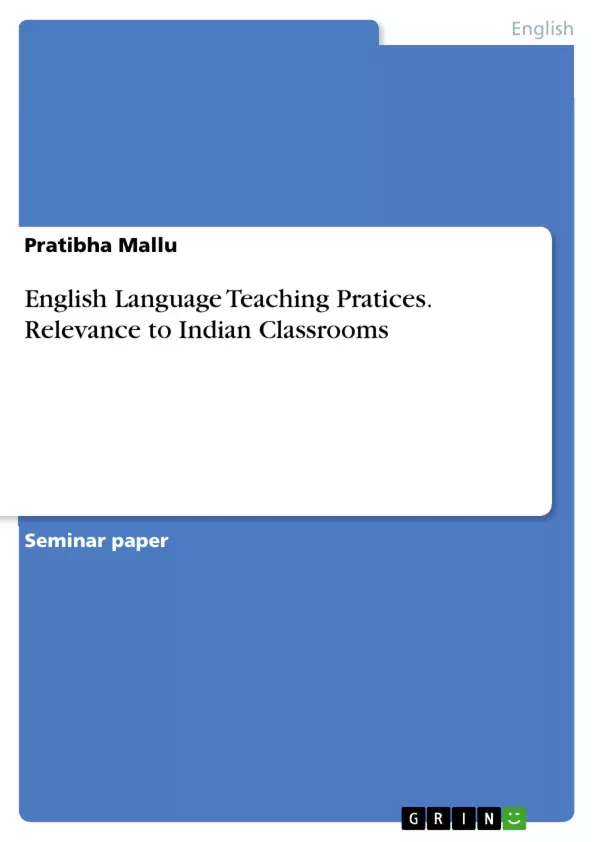This article covers some of the best practices I have come across in my experience as a second language instructor: Using the target language in the classroom, understanding students' learning style and adopting teaching accordingly, using natural language, using technology, activating prior knowledge with English language learning, encouraging students to adopt a hands-on approach to language learning, etc.
Teachers are to be adaptable continuously to the best teaching practices to meet the changing demands of learners. Since language teaching practice is cyclic and self-reflective, teachers have to practice and improve by adding new practices and eliminating not-so-promising practices. The routine classroom learning is not much appreciated. Students would like to have some innovatory practices. Using the target language as much as possible in the classroom is recommended. Students have to be provided with exposure to the target language. Learning situations in the classroom act as model situations that give consolidated and continuous practice. Students need continuous practice and exposure to the target language. Technology provides varied natural learning environments along with the culture to learners. Teachers have to provide suitable environments and also adapt to the learners' level, style and demands. Learner motivation can be activated by rewarding students. Since grammar is the backbone of language, building students' grammar is essential teaching practice. Student’s prior knowledge can be expanded by revising and rebuilding vocabulary and grammar for the reinforcement of learned skills.
Inhaltsverzeichnis (Table of Contents)
- Abstract
- Introduction
- Using the target language in the classroom
- Understanding and adopting to students' learning style.
- Using natural language
- Using technology for language learning.
- Activating previous knowledge with English Language Learners....
- Encouraging students to adopt a hands-on approach to language learning...
- Building language skills through grammar.
- Consolidating language.......
- Bringing language and culture alive in the classroom
- Conclusion
Zielsetzung und Themenschwerpunkte (Objectives and Key Themes)
This article examines best practices in second language instruction, with a focus on the application of these practices in Indian classrooms. It explores key principles of effective teaching, aiming to provide teachers with actionable strategies for engaging students and enhancing their language learning experience.
- Using the target language effectively in the classroom
- Understanding and adapting teaching methods to diverse learning styles
- Leveraging technology to create dynamic and interactive learning environments
- Activating prior knowledge and engaging learners in hands-on activities
- Building language skills through a balanced approach to grammar and communication
Zusammenfassung der Kapitel (Chapter Summaries)
- Abstract: This section introduces the main themes of the article, outlining the best practices in second language teaching discussed throughout. The author emphasizes the importance of adopting a dynamic and self-reflective approach to teaching, continuously seeking new practices and refining existing ones.
- Introduction: The introduction explores the importance of adapting teaching practices to meet the evolving needs of learners. The author highlights the significance of lesson planning and its role in effective teaching, emphasizing the need for flexibility and responsiveness to student needs.
- Using the target language in the classroom: This section focuses on the importance of maximizing target language usage in the classroom. The author discusses how using the target language promotes natural language acquisition and how limiting mother tongue usage can hinder the learning process.
- Understanding and adopting to students' learning style: This chapter delves into the importance of tailoring teaching methods to accommodate individual learning styles. It emphasizes the need for teachers to identify and address the specific needs of each learner to optimize their learning experience.
- Using natural language: This section highlights the significance of incorporating natural language usage into classroom activities. It discusses the role of technology in providing authentic and engaging learning environments.
- Using technology for language learning: This chapter explores the use of technology as a tool for language learning. It emphasizes the potential of technology to create dynamic and interactive learning experiences, fostering authentic language use.
- Activating previous knowledge with English Language Learners....: This chapter focuses on the importance of activating prior knowledge and engaging learners in meaningful ways. It explores strategies for connecting new learning to existing knowledge, making the learning process more relevant and accessible.
- Encouraging students to adopt a hands-on approach to language learning...: This section highlights the benefits of hands-on learning in language acquisition. It discusses activities that encourage active participation and engagement, fostering a deeper understanding of the target language.
- Building language skills through grammar: This chapter focuses on the role of grammar in language learning. It underscores the importance of building a solid foundation in grammar to support effective communication and comprehension.
- Consolidating language.......: This section explores strategies for reinforcing learned language skills. It highlights the significance of providing opportunities for students to practice and consolidate their understanding of the target language.
- Bringing language and culture alive in the classroom: This chapter focuses on the importance of integrating language and culture in the classroom. It discusses strategies for creating immersive and engaging learning experiences that connect language learning with cultural understanding.
Schlüsselwörter (Keywords)
This article focuses on best practices in second language teaching, specifically targeting English language learners in Indian classrooms. Key themes include the importance of using the target language, understanding learning styles, utilizing technology, activating prior knowledge, and building language skills through grammar and communication.
- Quote paper
- Pratibha Mallu (Author), 2021, English Language Teaching Pratices. Relevance to Indian Classrooms, Munich, GRIN Verlag, https://www.grin.com/document/985568



